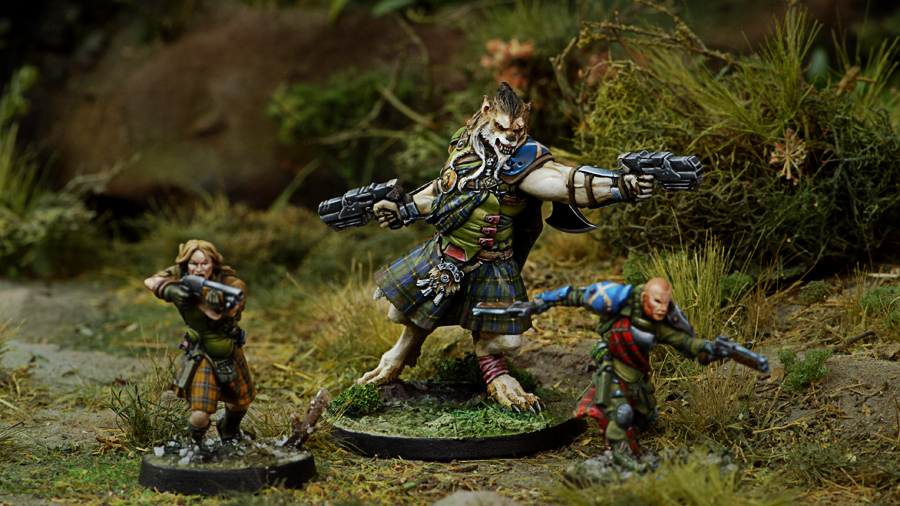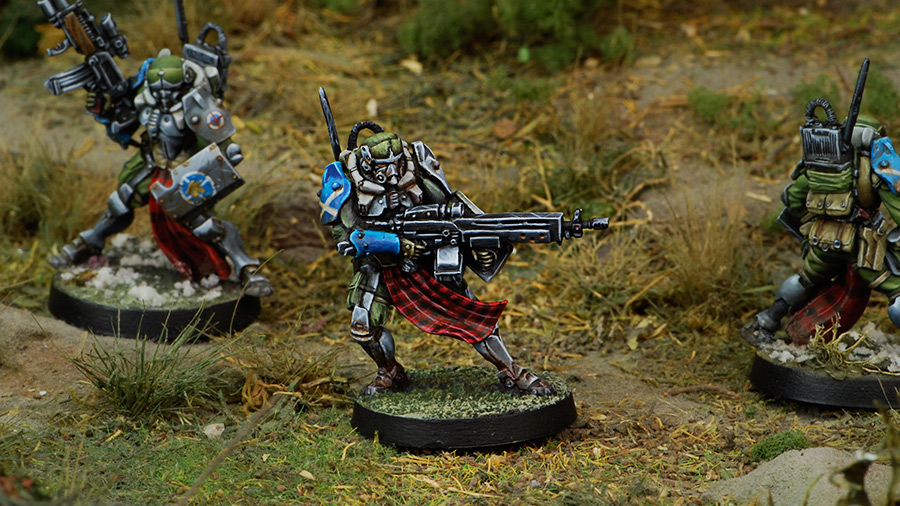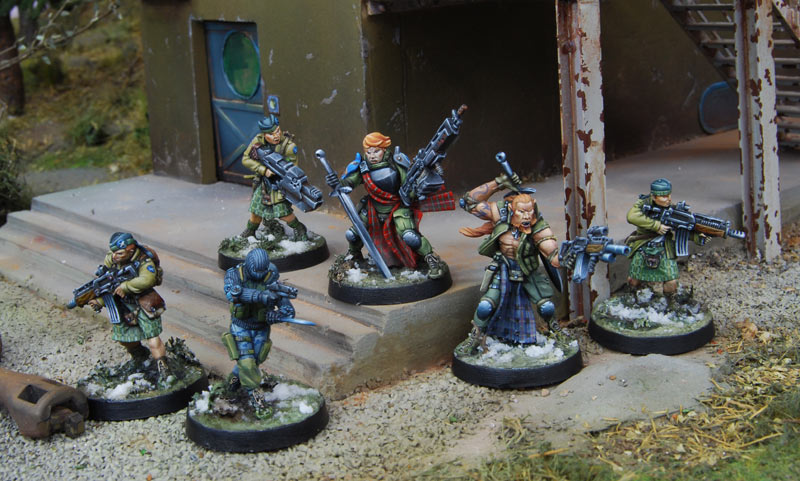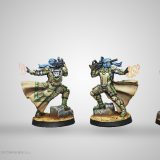Caledonian Highlander Army
The Caledonians are the descendants of the Anglo-saxon pioneers of Ariadna. Their society is based on a system of Clans that is structured around political, social, cultural and territorial values.
A clan is a community built up around a bloodline. They are larger than a family, but are still united by a close relationship. The clanfolk have a shared sense of identity and are loyal to each other from the first day the first settlers set foot on Dawn.
The Clans are the primary social groups in Caledonia and are organized around warrior chieftains who hold true to their authoritarian task in the clan society.
The chieftains are the guides of the clans and they are the ones who make the tough decisions and aid their clanfolks in the fight for survival. They are the warlords, the governors, the judges, the directors and the official representatives of the clans. By fulfilling this task the chieftain get the utmost loyalty of his clan in return.
Caledonia is the northern territory of Ariadna It is marked by mountains, cliffs, deep valleys , many lakes and dense forested zones.
Because of the natural geography of the Caledonian territory, most of the population quickly densed into small and loyal communities, isolated from each other. These social groups would later become the clans.
This way, each clan developed its own customs, laws and values, and each clan has its own juridical system. There is one governmental body that unites all the clans; the Caledonian Justiciar, who is a chieftain elected by all the clans, and therefore the leader of the Caledonian people. He resides in the House of Clans and while he has little influence over regional matters, as each clan is a sovereign in its own right, he is the representative of the Caledonians in national matters and internal peace.
The House of Clans has a seat for a representative for each of the bigger clans, and the smaller clans that can’t get into the House, usually ally themselves with a clan that does. The system of clans gives each of the clans a relative freedom, and the Justiciar is there to unite them all as Caledonians towards their foreign enemies and allies.
History of Violence
Caledonia is born out of violence. The harsh conditions of the natural habitat of the Caledonians combined with frequent Antipodes raids on their communities shaped the culture of the Caledonians. It became a culture where proactive aggressive behaviour was applauded and used to fight off any attackers from their territories.
The isolated and harsh conditions also made the Caledonians distrust members of other clans, as they competed for the same scarce resources. This violent nature would become the birthplace of Caledonian culture.
The rivalry between Caledonian clans quickly escalated into a series of smaller, constant conflicts that devastated Caledonia and any hope for a lasting peace within the nation.
One of the most valuable resources the clans fought over were the Teseum veins. Teseum is a light but strong metal and of great value to the Ariadnan economy. It wasn’t until the Contact Phase, when a new market for Teseum opened up, that the Caledonians united themselves under the Justiciar. Now Teseum was something more than just valued metal, it was a way to unimaginable wealth for the entire Caledonian society. Feuds were resolved so that the Teseum industry wouldn’t get disturbed.
The area is still under attack from Antipodes, and small skirmishes between clans erupt now and then for personal or clan honour.
Wealth of Teseum
The Caledonian economy is built around the Teseum industry. The nation of Caledonia earns the biggest and richest veins in of this internationally valued neomaterial. All the clans are involved in the industry. Some have the ability to set up big mining facilities, other clans are small producers and some only have processing factories or manage the transfer to the Merovingian and Cossack territories, where it can be shipped off-world.
The wealth of a clan is measured by its Teseum deposits. As it is the main component of the Ariadnan armour and ammunition it also shows a Clans military strength. Some clans own many Teseum items like cutlery and jewelry. While these items are seen as boasting, it is a valuable asset, as all these items can be melted and used as weapons in no-time.
The Hybrid Problem
Due to Caledonian’s lengthy borders that contact the Antipode areas, the Caledonians have to constantly fight off Antipode raids on their settlements. During these continued attacks, many of the Caledonian women got bitten by these natives of Dawn. A pregnant woman bit by an Antipode bears a child with a genetic mutation. It will grow up a hybrid; a human being with Antipode features. They are called hybrids, half-breeds or Dogfaces. A Dogface is the physical evidence of an Ariadnan unable to protect hishome and family. Each Dogface is the result of the inability of a Highlander to protect their pregnant wives from the Antipodes.These hybrids shame the Caledonians. The fate of the Wulvers is even worse, as it shows not only the shame, but also the fact that a pure Caledonian bred with a half-breed.
This attitude of the Caledonian society causes the Dogfaces and Wulvers to live their lives as second-class citizens. While they are allowed to live between the rest of the Caledonians, they are destined to the worst jobs in the mines, the criminal underworld or homeless, without any possible solution to their situation other than alcoholism or death.
There are only two ways for a Dogface to become a somewhat respected participant of the Caledonian society. One is to join the Dog-Bowl teams, where they fight for the enjoyment of the entire Human Sphere.The other is joining the army, where their untamed and furious nature is put to good use.
The Dogfaces and Wulvers have a lower average intelligence than humans, but make up for it in pure strength.
But even though these creatures have a second-class status in society, they are loyal to their clans and will take up arms to anyone who forms a threat to their clans. They are good at fighting, and will do so in unfathomable courage. A Wulver and Dogface will never back down from their duty to protect the clan.
It is this ferocious nature during the protection of the Caledonian clans that sparked the Dog nation movement where the Dogfaces and Wulvers fight for recognition of their contribution to the Caledonian and Ariandnan society as a whole.
The Caledonian Army
Years of inner conflict between the Caledonians has forged a nation of born and bred warriors. Each Caledonian from a young age learns that he has to defend himself, his clan and their resources to all kinds of threats.
The strength of the Caledonian army lies in its warring clans and the hordes of fiery Highlander fighters that emerge from the natural and hostile habitat of Caledonia. With impetuous fury and devastating firepower and the untamed hybrid bands the brute force of Caledonia is a army to be reckoned with.
The Clan system is maintained in the army, and while warriors from different clans can form a regiment, they will only answer to their own superiors in the fight. The army resolves these problems by using superior commanders to guarantee the success of joint operations.
These frictions in the command structure caused the defeat of the Highlander Army during the Separatist Wars.
Caledonian Volunteers

The Caledonian Volunteers
“Bydand” (Steadfast, abiding) Caledonian Volunteers Corps’ Gaelic motto.
The Caledonian Volunteers follow the ancient Scottish tradition that a warrior enlists himself in the army to participate in foreign wars. They were formed when the Separatist Wars were expected to break loose. Nowadays the form the core of the Highlander Army.
The men and women that form the Volunteer regiments come from different clans and have a diverse background. Some come from the desperate gutters of the urban areas, others hail from the mining facilities where they work and many are simple thugs. Because of this they have a reputation as troublemakers and their unruly attitude only helps this prejudice.
The Volunteers fight in many battles outside of Caledonian territory and aren’t afraid to die in foreign lands. They accept missions in the most untamed and freezing areas of the planet and only get paid a meager salary and a can of ration.
The Scots Guard, 6th Caledonian Infantry Regiment

The Scot Guard
“Air son ar duthchais” (For our heritage) Gaelic motto of the Scots Guards.
The Scot Guard is established as a reaction to the heavy losses during the Separatist Wars. The Caledonian Army needed a regiment that wasn’t tied down by the clan system and the loyalty to one’s own.
This unit would only answer to the Caledonian Justiciar’s command. To do so the Merovingian Colonel Augier was hired to train these men in modern combat techniques, forming the Scots Guard as a highly disciplined and trained regiment, both skilled in ranged and close combat fighting.
Augier’s untimely death is contributed to the Cossack Intelligence, who are the only ones that benefited from the rivalry between the Caledonian clans. His second in command took over the training and specialized the Scots Guards in ambush and surprise attacks.
The Scots Guard shone during the Commercial Conflicts, where they took it upon themselves to take out better-equipped and professional forces of the foreign clandestine armies. Because the Scots Guard has the characteristic bravery of the Highlanders but lacked their furious madness in combat this regiment was the first that was drafted by O-12 to help during the Paradiso conflicts, making them the first Caledonian unit to be assigned off-world.
The Scots Guard is the melting pot of the best of the Caledonian armies; the trickery of the S.A.S. commandos combined with the modern combat techniques.
2nd Irregular Cameronians Regiment

The Cameronian
“Deas Gu Cath” (Ready for the fight) Cameronian Regiment’s motto.
The Cameronians are the Dogface regiments of the Highlander Army. There aren’t many better options for a Dogface outside the Dog-Bowls and the Army. Slaving away in the Teseum mines or starving to death are definitely less appealing options..
The Cameronians are trained in the basics of killing, and they’ll have to sort out surviving for themselves. The Dogfaces are werewolves that turn into ferocious beasts when their emotions take over. And in battle, they will take over. The Cameronian regiments are the only place where they can let go of their inner nature and start fighting the enemies of Caledonia.
The Caledonian Mormaers

The Caledonian Mormaers
“Dileas gu bas” (Loyal until death) Motto of the First Regiment of Caledonian Mormaers.
The Mormaers are the height of Teseum-provided military power. In the society of Caledonia, Teseum is a symbol of wealth and power. The Mormaers are visibly the most elite troops of the entire Caledonian Army. The cost of their Teseum armour is so high that only a few Caledonians can afford to pay for it. Even their ammunition is made from this valued and tough metal.
Their name is derived from the Scottish word for ‘Duke’, and it fits the Mormaers as they are indeed the most elite units of the Army.
It is a great prestige for a clan to enlist their best men as Mormaers to the Army. The necessary tools, armour and weaponry for the Mormaers require a big investment in Teseum. As a result, most of the Mormaers are the scions of the clan’s elite and many have a familial bond between them. They are the aristocracy of Caledonian society, and because of that they are often not called by their rank, but are called ‘sire’.
They are a front line regiment and always face exceptional conditions and situations. Still their elitist identity remains intact and it is the bark of their rifles that is the first, and usually the last, word in many conflicts.

















Scots are not, in general, Anglo-Saxon, only some Lowlanders (SE historically) was historically Anglo-Saxon and they still developed a seperate language than English (although very similar, not technically a dialect due to the same age).
Highlanders are Celtic, with some Viking thrown in. They speak Gaelic, traditionally, and it is still present in Caledonia.
Yep, you’re definitely right, but this is what the Infinity fiction tells u. 😉 The Caledonian Highlander armies aren’t Scottish per se, but hail from the Anglo-Saxon regions on earth (which seems to be mainly UK). The fall back Scottish heritage became prominent later on, when the Anglo-Saxons decided to follow their nationalistic feelings during the civil war on Dawn, becoming the Caledonians.
You’re both so off base I have to comment. I’m a direct descendant of the one of the 7 Caledonian Chiefs, who answered directly to their High King only, otherwise they are autonomous. They were the people known as the Picts to the Romans, or the Cruithne to the Gaels. They had a distinct identity apart from the Gaels, which became obscured as the two kingdoms combined to form Scotland, and their legacy remains in the names of the mountains and rivers, and in the surnames of people. So they are distinctly Scottish, they founded Scotland primarily with the Gaels. While I’m sure there was some intermingling with the Anglo-Saxons, they were a completely separate identity, descending from Iberian Celts. They are very closely related to the Irish who also have a tribe called the Cruthin. Cruithne, Pictish, and Cruthin all mean painted, or tattooed people.
Within the fictional universe of Infinity, the Caledonians decent from Anglo-Saxon colonists.
You’re right. The real Scotsmen has little to do with Anglo-Saxons culturally or genetically, but within the Infinity fiction, the historical/genetic Scotsman isn’t a thing.